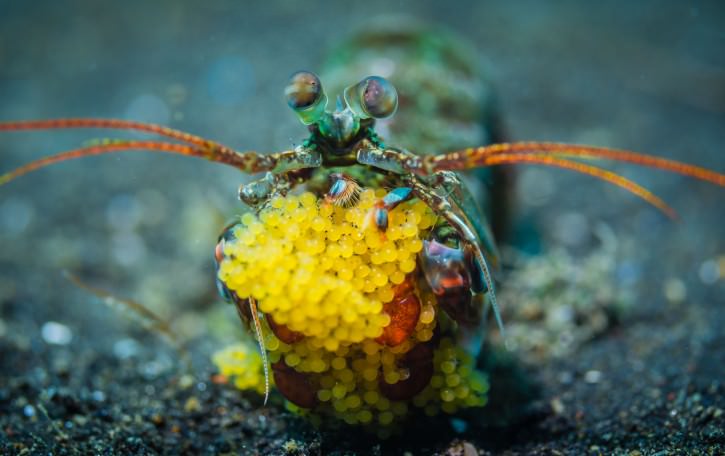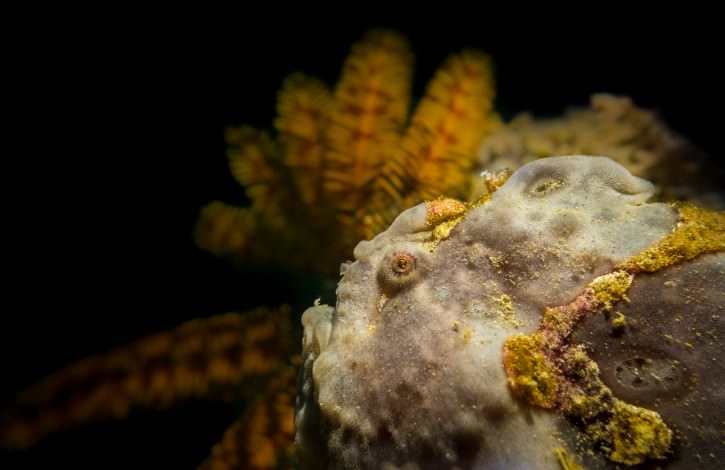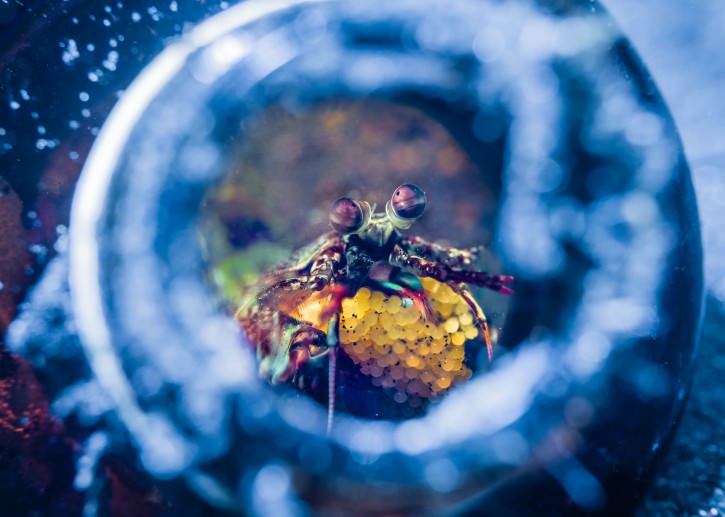News
How much is a photo worth?

[hr style=”single”]
I originally wrote this article around three years ago, after a great Lembeh trip marred only by this particular event, and have decided that it’s a very topical issue with some of the luminaries of the underwater photography world now at loggerheads about this sadly on trend bad behaviour.
I must thank Alex Tattersall for a great talk about this at DIVE 2016 which I must fess up I didn’t see personally but enough of my friends did and reported back to me. He was also being brave enough to come clean about his own past indiscretions, and pointing out miscreants still directly doing this sort of thing, or allowing it to happen and thus condoning it.
On my first trip to Indonesia I was aware of the guides willingness to orchestrate the marine life for the benefit of the photographer, but to be totally honest I have never done this myself and have always called them out on it. That is if I was aware of it.
Looking back now, there was more than one occasion that I have had my attention alerted to the most incredibly positioned nudibranch, and now in retrospect I think that the murkier waters of the Lembeh Straits and those surrounding Manado have perhaps served the purpose of hiding this sort of thing in less than plain viz.
[hr style=”single”]

I really do wonder now if all the wonderfully positioned nudibranchs that I’ve had pointed out to me really were in such great positions. Sadly all this manipulation talk has now made me doubt a lot of these shots, mine included.
Prime Witnesses
I wasn’t the only one to witness this event, and in the great scheme of things it amounts to very little.
Unfortunately though it does point to a worrying trend in the world of underwater photography that I feel strongly about.
Not all share my views, granted – so by all means let your own conscience guide you.
Because of the events behind the couple of pictures I took, I could never with good conscience post these pictures without also giving the backstory to them, which really changes things quite a lot for me.
It has made me wonder how many others would do the same, when presented with the opportunity, to get a fairly unusual and unique shot in similar circumstances.
And also, how many others have taken pictures that I have been inspired by and wondered at, that are now tainted with the doubt that all may not be quite as it seems?
Maybe I’m just incredibly naive, and this is my wake up and smell the coffee moment.
OK: Here’s the story

The dumping grounds that are the Lembeh Straits are famed for the diversity of marine life of all shapes and forms, and discarded bottles actually make great shelters and homes for lots of creatures.
Towards the end of a dive in the Lembeh Straits, famed for its incredible diversity of weird and wonderful marine life, myself and some friends and fellow work shoppers were pootling about in the shallows.
One of our guides – unfair to name him – signalled for our attention as they do by tapping on his tank with his pointer.
He was about 20m distance and invisible to us, as the visibility was less than 10m. Nevertheless we found him quickly.
He pointed triumphantly to a small Mantis Shrimp on the sand, completely exposed.
We saw no burrow and there was no obvious shelter for this creature. They have a tendency to be quite shy, but often also a little inquisitive, so seeing one completely out of its hole was odd, but still appeared quite a credible scenario.
Being photographers we felt lucky that this particular individual was in a great position to get a shot.
As I lined up for the picture I realised through the magnified screen image that it was clutching a mound of eggs.
Amazing I thought, what are the chances of that eh?
I had previously only encountered egg holding Mantis hiding under ledges, and always inaccessible to me in the past.
I had cause a few years earlier to actively prevent a guide from removing one from its mound by poking it out with his pointer stick, and upon admonishment post dive he said that if I wanted to guarantee a shot of one with eggs then this was a sure fire method, and worse still that he had done this dozens of times before for other photographers from all four corners of the globe… without any previous complaints!
Anyway, back to the current situation. I took a shot and my dive buddy Phil waved and pointed behind me – our guide had moved on.
Coming from a broken home
Behind me and a few metres from our transfixed shrimp was the fragments of a broken beer bottle, the neck and the base still intact, but the middle clearly broken with the contents of sand and fragments of shells and remains of small creatures now scattered around.
I have encountered Mantis shrimps living in glass bottles before, and I was lucky enough to get a shot of one living inside an intact bottle last year, which I was even more chuffed with because I’d found it myself without the help of a guide.
So I will regularly check the discarded beer bottles and other containers that make for a great des-res for marine life when diving the underwater dumping grounds that actually make Lembeh such a fascinating and contrary place to dive.
On closer inspection of the shards of broken glass, they looked very freshly broken to me with no dirt build up and very sharp clean edges.Putting two and two together a horrible possibility dawned upon me… that someone had actually broken this bottle and frightened the expectant creature out into the open.
Phil clearly thought the same signalling as such, and to underline this thought, the poor shrimp scuttled back into the neck of the bottle.
I took a shot of it in there with its eggs, and resolved to only publish the picture with this story attached, as my conscience wouldn’t let me do anything other.
Bottle Half Empty
Phil gently pushed the rear of the neck of the bottle back into the sand affording her some protection from the rear, but now her home was a quarter of the size it was shortly before.
We left her be and returned sadly to the surface, where our guides were slowly making their way ahead of us back to the boat.
Now, bearing in mind I have absolutely no proof of our guide’s part in all this, I kept mum, and didn’t let my anger get in the way of rationale. I didn’t need to bring the subject up though, as the guide in question, with a big smile on his face, brought up the Mantis Shrimp find himself – almost triumphantly.
I asked him how he had found it, and he said it was just there resting on the sand. I mentioned finding the bottle and he said he hadn’t seen it, which I doubted in the circumstances. He then contradicted himself by saying that he had seen the broken bottle and it must have been broken by guides on the other boat moored close by.
I have no way of knowing for definite if he was or wasn’t telling the truth, but I am sure that this bottle, intact, had been her home very recently before we saw her out and exposed, and someone had broken the bottle; who, we will never know for sure. What is worse is that it was broken by parties unknown for the benefit of photographers.
Is any photograph worth the wanton destruction of any creature’s habitat? Whoever broke this bottle thought so.
Are photographers such needy and demanding clients that the guides deem it necessary to go to these lengths to please their relatively wealthy clients?
This is not an isolated incident; I have seen other incidents of marine life manipulation for the benefit of photographer clients – not always as bad as this one, but in light of this they are the thin edge of the wedge I fear.

The underwater photographic community at large needs to try and police ourselves and each other and show intolerance for manipulating marine life. We often give people a hard time for digitally manipulating the underwater realm, but surely pushing the pixels is a small crime by comparison?
[hr style=”single”]
At the time the only possible solution that I could think of that was appropriate in the circumstances was to suggest that the ‘big guy’ watching over everything knew what had happened, as he sees everything.
I’m not in the slightest bit religious personally but am aware that in this part of Indonesia everyone is devoutly christian, so I thought it would maybe make them think a bit if they had done exactly what we thought they had. If they hadn’t then no harm done, they would have clear consciences – but I did notice a fearful look flash across one of their faces, so perhaps my impression was right.
As mentioned in the update at the start of this post, we have come along quite a way since I originally wrote this blog and it has now become the current hot topic, with not only underwater photographers being held to account but also a slew of on land photographers getting up to all sorts of tricks to, in most cases, win big money prizes for their tawdry efforts.
So I’m glad it’s in the public eye, and just like the diving community no longer tolerates manhandling turtles and big fish and dolphins, we will hopefully come to abhor all sorts of manipulation for short term photographic and often financial gain.
I would also say that I don’t blame the guides completely for these actions as there is a massive disparity in income between them and their comparatively rich clients, and in the intervening years I have heard of a well known Far Eastern photographer actually having laminated cards printed with prices in US dollars in tips for the production of differing creatures on dives. This surely puts the guides under a lot of pressure, as $50 is a lot of money to them, which was the amount being flaunted as up for grabs if a hairy octopus was produced in one particular case that I heard of.
And it’s not just Far Eastern photographers doing it; I’ve heard of more than one European behaving badly to gain photographic kudos. One had a guide bring up specimens for them to shoot from greater depths than they were allowed to go because of PFO induced depth restrictions. Really?
I think the solution is easy: I would personally discourage the habit of having lists of desirable creatures, and just shoot what’s there, without any pressure on the guides to deliver, and to also tip based on an overt absence of manipulation at the culmination of a trip.
What to do about competitions though, often with huge payouts and at the very least kudos aplenty? The organisers and judges need to be very very careful with what they reward based on their own experiences and familiarity of the underwater world, and if there is the slightest sniff of doubt then they perhaps shouldn’t place a picture. It’s a shame and perhaps unfairly penalises the honest, but what else do you suggest?
[hr style=”single”]
 Duxy is the in house photo-pro for UK-based dive tour operator Scuba Travel. To find out about availability on Scuba Travel’s underwater photography workshops hosted by Duxy click here.
Duxy is the in house photo-pro for UK-based dive tour operator Scuba Travel. To find out about availability on Scuba Travel’s underwater photography workshops hosted by Duxy click here.
Gear News
Scubapro Free Octopus Promotion 2024

Free Octopus with every purchase of a SCUBAPRO regulator system
Just in time for the spring season, divers can save money with the FREE OCTOPUS SPRING PROMOTION! Until July 31st SCUBAPRO offers an Octopus for free
with every purchase of a regulator system!
Get a free S270 OCTOPUS with purchase of these combinations:
MK25 EVO or MK19 EVO with A700
MK25 EVO or MK19 EVO with S620Ti
MK25 EVO or MK19 EVO with D420
MK25 EVO Din mit S620Ti-X
Get a free R105 OCTOPUS with purchase of the following combinations:
MK25 EVO or MK19 EVO with G260
MK25 EVO or MK17 EVO with S600
SCUBAPRO offers a 30-year first owner warranty on all regulators, with a revision period of two years or 100 dives. All SCUBAPRO regulators are of course certified according to the new European test standard EN250-2014.
Available at participating SCUBAPRO dealers. Promotion may not be available in all regions. Find an authorized SCUBAPRO Dealer at scubapro.com.
More information available on www.scubapro.com.
Blogs
Northern Red Sea Reefs and Wrecks Trip Report, Part 3: The Mighty Thistlegorm

Jake Davies boards Ghazala Explorer for an unforgettable Red Sea diving experience…
Overnight, the wind picked up, making the planned morning dive a bit bumpy on the Zodiacs to the drop point on Thomas Reef. There, we would dive along the reef before descending through the canyon and then passing under the arch before ascending the wall with a gentle drift. The site provided great encounters with more pelagic species, including shoals of large barracuda, tuna, and bigeye trevally.
Once back on the boat, it was time to get everything tied down again as we would head back south. This time, with the wind behind us, heading to Ras Mohammed to dive Jackfish Alley for another great gentle drift wall dive before then heading up the coast towards the Gulf of Suez to moor up at the wreck of the Thistlegorm. This being the highlight wreck dive of the trip and for many onboard, including myself, it was the first time diving this iconic wreck. I had heard so much about the wreck from friends, and globally, this is a must on any diver’s list. Fortunately for us, there was only one other boat at the site, which was a rarity. A great briefing was delivered by Ahmed, who provided a detailed background about the wreck’s history along with all the required safety information as the currents and visibility at the site can be variable.

Kitting up, there was a lot of excitement on deck before entering the water and heading down the shoreline. Descending to the wreck, there was a light northerly current which reduced the visibility, making it feel more like the conditions that can be found off the Welsh coast. At 10m from the bottom, the outline of the wreck appeared as we reached the area of the wreck which had been bombed, as our mooring line was attached to part of the propeller shaft. Arriving on deck, instantly everywhere you looked there were many of the supplies which the ship was carrying, including Bren Carrier tanks and projectiles that instantly stood out.

We headed around the exterior, taking a look at the large propeller and guns mounted on deck before entering the wreck on the port side to take a look in the holds. It was incredible to see all the trucks, Norton 16H, and BSA motorcycles still perfectly stacked within, providing a real snapshot in time.

Overall, we had four dives on the Thistlegorm, where for all of the dives we were the only group in the water, and at times, there were just three of us on the whole wreck, which made it even more special, especially knowing that most days the wreck has hundreds of divers. Along with the history of the wreck, there was plenty of marine life on the wreck and around, from big green turtles to batfish, along with shoals of mackerel being hunted by trevally. Some unforgettable dives.

The final leg of the trip saw us cross back over the Suez Canal to the Gobal Islands where we planned to stay the night and do three dives at the Dolphin House for the potential of sharing the dive with dolphins. The site, which included a channel that was teeming with reef fish, especially large numbers of goatfish that swam in large shoals along the edge of the reef. These were nice relaxing dives to end the week. Unfortunately, the dolphins didn’t show up, which was okay as like all marine life they are difficult to predict and you can’t guarantee what’s going to be seen. With the last dive complete, we headed back to port for the final night where it was time to clean all the kit and pack before the departure flight the next day.

The whole week from start to finish on Ghazala Explorer was amazing; the boat had all the facilities you need for a comfortable week aboard. The crew were always there to help throughout the day and the chefs providing top quality food which was required after every dive. The itinerary providing some of the best diving with a nice mixture of wreck and reef dives. I would recommend the trip to anyone, whether it’s your first Red Sea liveaboard in the Red Sea or you’re revisiting. Hopefully, it’s not too long before I head back to explore more of the Red Sea onboard Ghazala Explorer.

To find out more about the Northern Red Sea reef and wrecks itineraries aboard Ghazala Explorer, or to book, contact Scuba Travel now:
Email: dive@scubatravel.com
Tel: +44 (0)1483 411590
Photos: Jake Davies / Avalon.Red
-

 News3 months ago
News3 months agoHone your underwater photography skills with Alphamarine Photography at Red Sea Diving Safari in March
-

 News3 months ago
News3 months agoCapturing Critters in Lembeh Underwater Photography Workshop 2024: Event Roundup
-

 Marine Life & Conservation Blogs2 months ago
Marine Life & Conservation Blogs2 months agoCreature Feature: Swell Sharks
-

 Blogs2 months ago
Blogs2 months agoMurex Resorts: Passport to Paradise!
-

 Blogs2 months ago
Blogs2 months agoDiver Discovering Whale Skeletons Beneath Ice Judged World’s Best Underwater Photograph
-

 Gear Reviews3 months ago
Gear Reviews3 months agoGear Review: Oceanic+ Dive Housing for iPhone
-

 Marine Life & Conservation2 months ago
Marine Life & Conservation2 months agoSave the Manatee Club launches brand new webcams at Silver Springs State Park, Florida
-

 Gear Reviews2 weeks ago
Gear Reviews2 weeks agoGEAR REVIEW – Revolutionising Diving Comfort: The Sharkskin T2 Chillproof Suit





